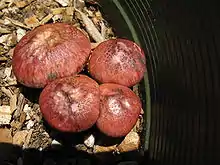Gymnopilus
Gymnopilus is a genus of gilled mushrooms within the fungal family Strophariaceae containing about 200[1] rusty-orange spored mushroom species formerly divided among Pholiota and the defunct genus Flammula. The fruit body is typically reddish brown to rusty orange to yellow, medium to large, often with a well-developed veil. Most members of Gymnopilus grow on wood but at times may appear terrestrial if the wood is buried or decomposed. Members of Pholiota and Cortinarius are easy to confuse with Gymnopilus. Pholiota can be distinguished by its viscid cap and duller (brown to cinnamon brown) spores, and Cortinarius grows on the ground. Beginners can confuse Gymnopilus with Galerina, which contains deadly poisonous species.
| Gymnopilus | |
|---|---|
 | |
| Gymnopilus luteofolius | |
| Scientific classification | |
| Domain: | Eukaryota |
| Kingdom: | Fungi |
| Division: | Basidiomycota |
| Class: | Agaricomycetes |
| Order: | Agaricales |
| Family: | Hymenogastraceae |
| Genus: | Gymnopilus P.Karst. |
| Type species | |
| Gymnopilus liquiritiae (Pers.) P.Karst. (1879) | |
| Diversity | |
| c. 200 species | |
The genus Gymnopilus has over 200 species worldwide.[2]
The name means naked pileus.
Psychoactive species
Fourteen members of Gymnopilus contain psilocybin,[3] although their bitter taste often deters recreational users. These species include G. aeruginosus, G. braendlei, G. cyanopalmicola,[4] G. dilepis,[5]G. intermedius, G. junonius, G. luteofolius, G. luteoviridis, G. luteus, G. purpuratus,[4] G. subearlei,[4] G. subpurpuratus,[4] G. validipes and G. viridans.[6] Subspecies of G. junonius from Japan are reported to contain psilocybin, while some western North American members are inactive.[7]
Several species of Gymnopilus contain bis-noryangonin [4-hydroxy-6-(4-hydrostyryl)-2-pyrone] and hispidine [4-hydroxy-6-(3,4-dihydroxystyryl)-2-pyrone], which are closely related to the alpha-pyrones found in kava.[8]
Phylogenetics
A 2003 phylogenetics study identified five well-supported clades within Gymnopilus:[2]
- the spectabilis-imperialis group
- nevadensis-penetrans group
- a clade formed by G. underwoodii, G. validipes and G. cf. flavidellus
- aeruginosus-luteofolius group
- lepidotus-subearlei group
Although the genus Gymnopilus was found to be monophyletic, the phylogenetically related groups do not support the traditional infrageneric classifications based on morphology.
References
- Kirk PM, Cannon PF, Minter DW, Stalpers JA (2008). Dictionary of the Fungi (10th ed.). Wallingford, UK: CAB International. p. 298. ISBN 978-0-85199-826-8.
- Guzmán-Dávalos L, Mueller GM, Cifuentes J, Miller AN, Santerre A (2003). "Traditional infrageneric classification of Gymnopilus is not supported by ribosomal DNA sequence data" (PDF). Mycologia. 95 (6): 1204–1214. doi:10.2307/3761920. JSTOR 3761920. PMID 21149021.
- Guzmán G, Allen JW, Gartz J (1998). "A worldwide geographical distribution of the neurotropic fungi, an analysis and discussion" (PDF). Ann. Mus. Civ. Rovereto. 14: 189. Archived from the original (PDF) on 2010-06-26. Retrieved 2007-01-10.
- Guzmán-Dávalos L. (2006). "A new bluing, probably hallucinogenic species of Gymnopilus P. Karst. (Agaricomycetideae) from Mexico". International Journal of Medicinal Mushrooms. 8 (3): 289–293. doi:10.1615/intjmedmushr.v8.i3.110. ISSN 1521-9437.
- Gotvaldova, Klara; Borovicka, Jan; Hajkova, Katerina; Cihlarova, Petra; Rockefeller, Alan; Kuchar, Martin (2022). "Extensive Collection of Psychotropic Mushrooms with Determination of Their Tryptamine Alkaloids". International Journal of Molecular Sciences. 23 (22): 14068. doi:10.3390/ijms232214068. ISSN 1422-0067. PMC 9693126. PMID 36430546.
- Gymnopilus Chemistry, Entheogen review, Vol VII No. 3
- http://www.svims.ca/ff0608.pdf
- Hatfield GM, Brady LR. (1969). "Occurrence of bis-noryangonin in Gymnopilus spectabilis". Journal of Pharmaceutical Sciences. 58 (10): 1298–1299. doi:10.1002/jps.2600581039. PMID 5388695.
- C.J. Alexopolous, Charles W. Mims, M. Blackwell et al., Introductory Mycology, 4th ed. (John Wiley and Sons, Hoboken NJ, 2004) ISBN 0-471-52229-5
- Hesler, L. R. (1969). North American species of Gymnopilus. New York: Hafner. 117 pp.